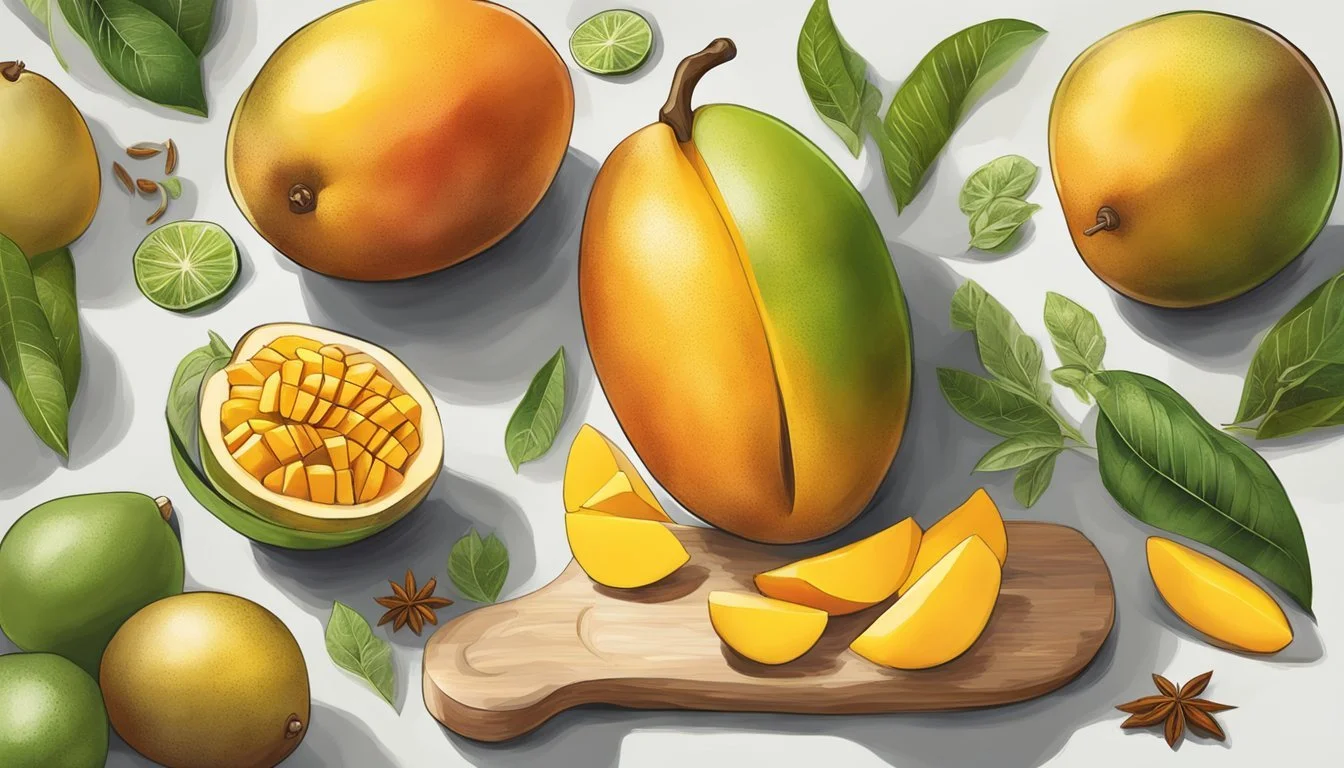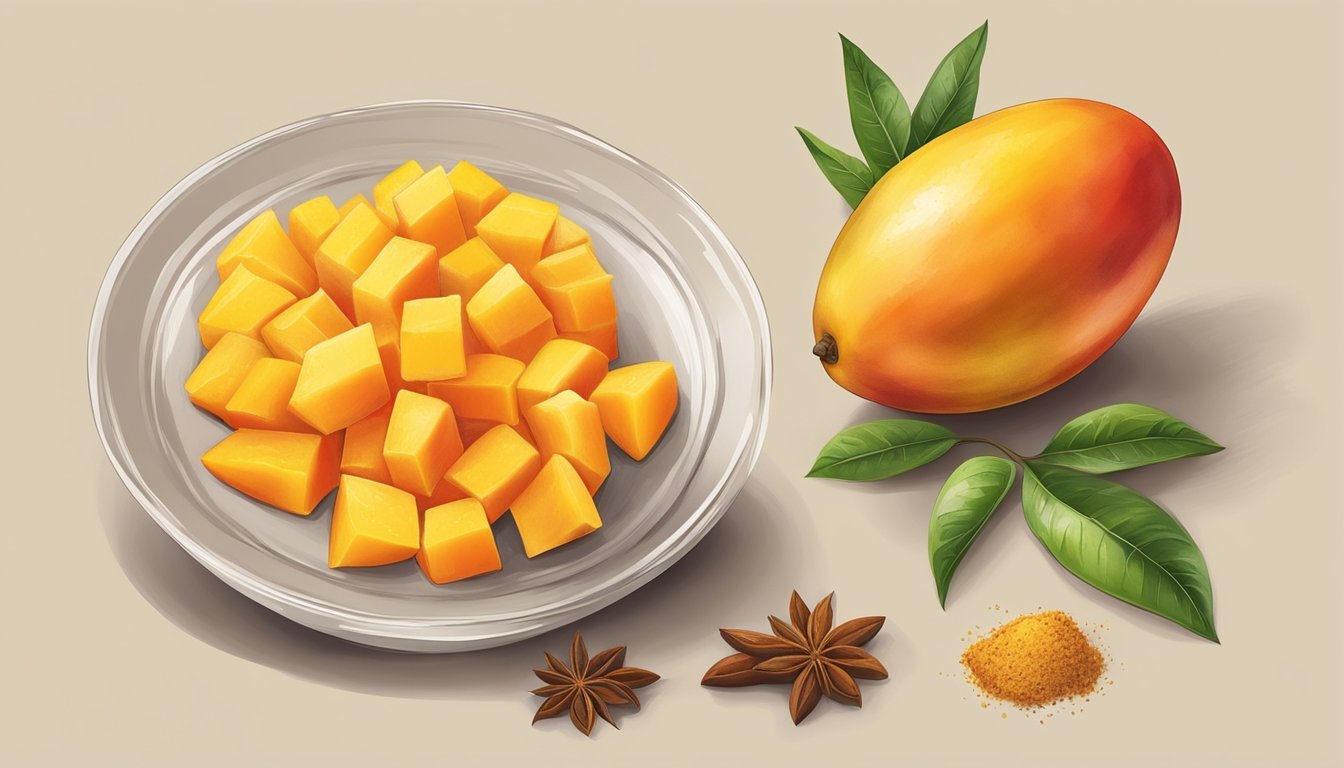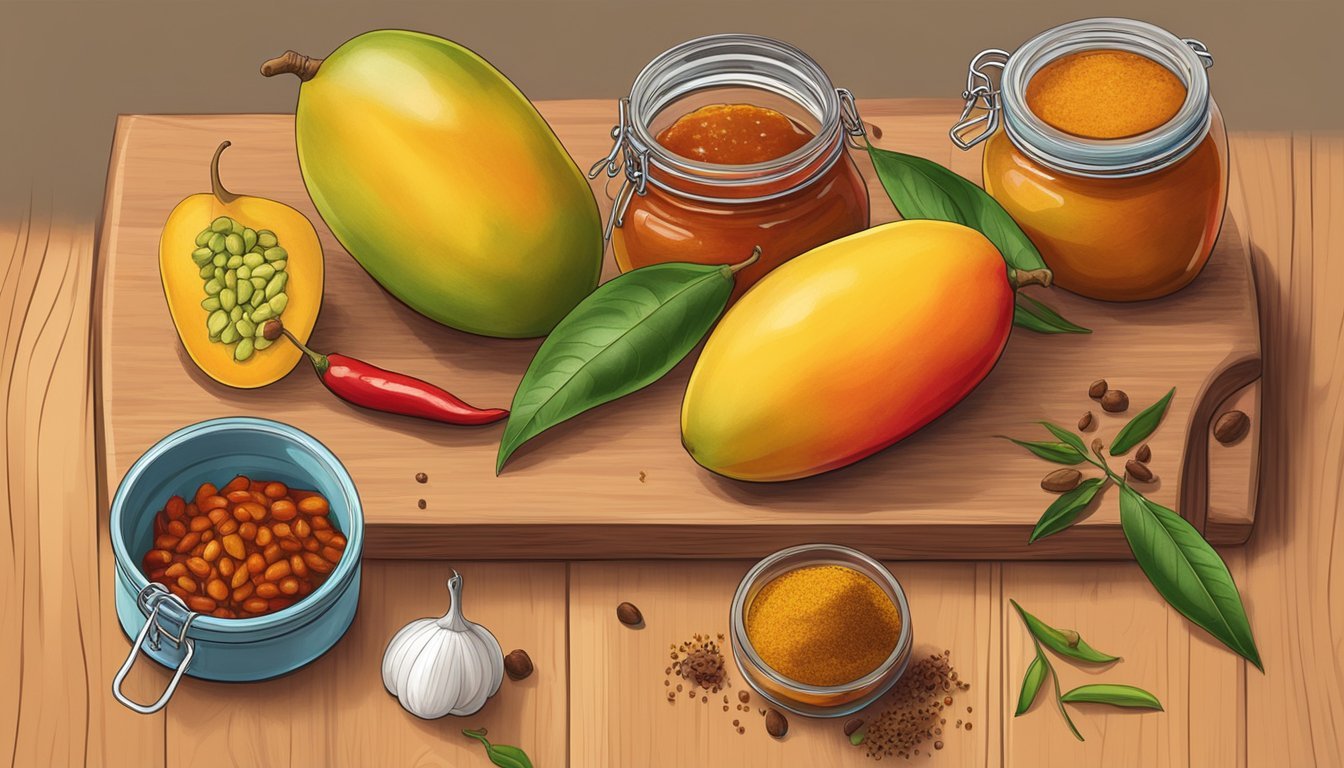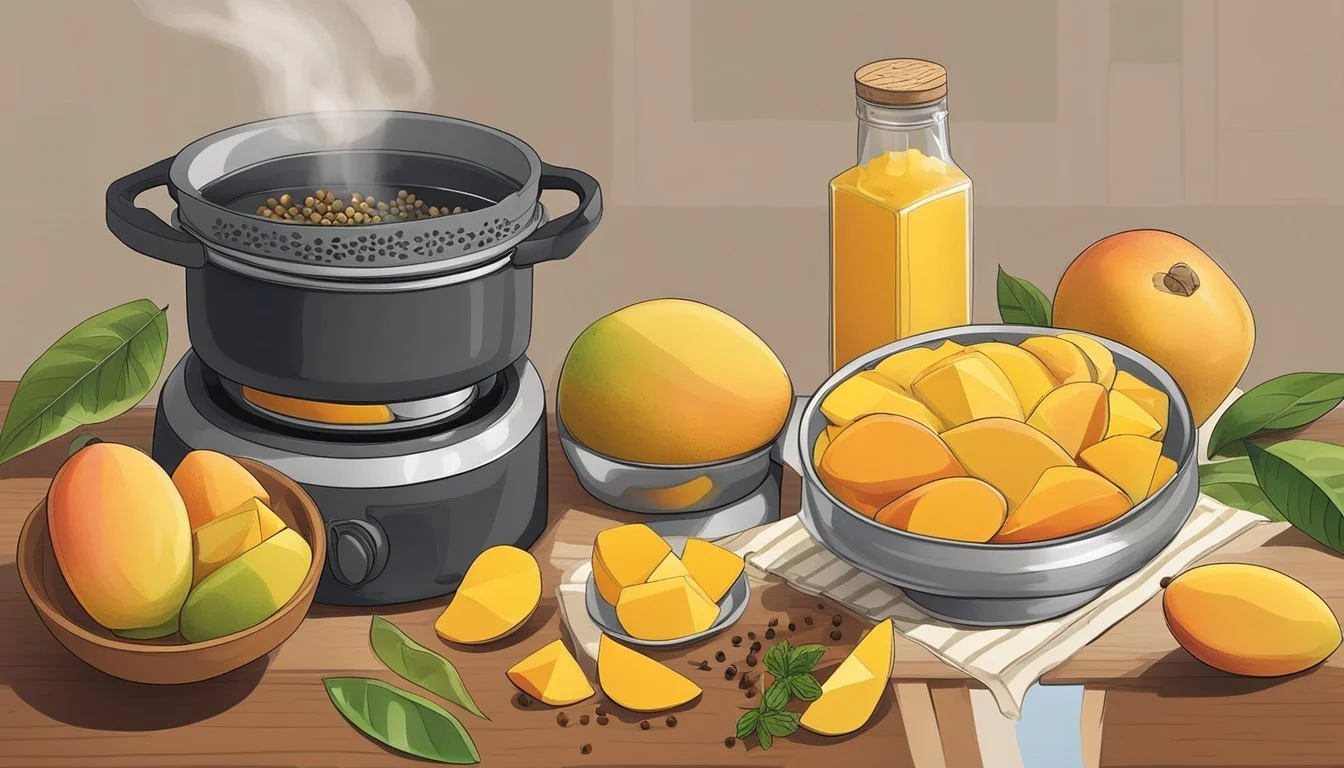Mango Peel Chutney
Enhancing Flavors with a Zesty Twist
Mango Peel Chutney is a vibrant and flavorful condiment that embodies the essence of tropical cuisine while championing a zero-waste approach to cooking. Made predominantly from mango peels, a byproduct often discarded, this chutney presents a spicy and tangy flavor profile that can elevate a variety of dishes. Its preparation involves blending the mango peels with a mix of traditional spices and sometimes a hint of sugar for a balance of heat and sweetness.
The practice of creating chutneys, a staple in South Asian cuisines, has long embraced the use of a wide range of fruits, herbs, and spices. Mango Peel Chutney follows in this tradition by incorporating ingredients like mustard seeds, curry leaves, and oil, but stands out for its innovative use of mango peels. This not only reduces food waste but also taps into the peels' rich flavor and potential health benefits.
With sustainability at its core, Mango Peel Chutney offers a consciously crafted option for those looking to add a spicy kick to their meals. It is typically prepared by first creating a thick paste from the peels and then tempering spices in oil to release their aromas, which are then combined with the paste. The result is a versatile and eco-friendly condiment suitable for pairing with a wide range of culinary delights.
The Origin of Mango Chutney
Mango chutney is an integral part of culinary traditions, with its roots deeply embedded in the rich soil of India's food history. It reflects a fusion of flavors that are synonymous with Indian cuisine.
Cultural Significance in India
In India, the origin of mango chutney can be traced back to the practice of Ayurveda and the need to preserve food. Mangoes, being seasonal fruits, required methods to be enjoyed throughout the year. Chutneys were invented as a means to not only preserve these fruits but also to enhance the nutritional profile and flavor of meals.
Mango chutney holds a place of prestige in Indian culture. It is often prepared in homes and served as an accompaniment to meals, enhancing the gastronomic experience. The preparation of this condiment varies across regions, incorporating local ingredients and methods, which reflect the diverse culinary landscape of India.
Ingredients typically used: Mangoes, sugar, vinegar, and spices such as ginger, cinnamon, and chili peppers.
Preparation: Involves simmering the ingredients, allowing the flavors to meld and the mixture to thicken into a rich, spicy-sweet condiment.
Consumption: Served with a variety of foods, from rice and flatbreads to grilled meats (What wine goes well with grilled meats?) and cheeses.
The chutney is not just a food item but represents a harmony of the six Ayurvedic tastes – sweet, sour, salty, bitter, pungent, and astringent. This balance is considered beneficial for digestion and health.
Indian mango chutney has also influenced other cuisines around the world, and its history includes a journey through colonial times when it was brought to the Western world, thus becoming a global staple in condiments.
Nutritional Profile
Mango peel chutney offers a combination of essential nutrients, making it more than a flavorful additive to meals. It is a nutritionally dense condiment that contributes vitamins, minerals, and macronutrients to the diet.
Vitamins and Minerals
Mango peel is rich in vitamin A and vitamin C, both of which are crucial for maintaining good eye health and immune function. Additionally, it contains a notable amount of potassium, which is important for heart health, and calcium, essential for bone strength. The chutney also provides a variety of other minerals and a spectrum of antioxidants that help protect the body from oxidative stress.
Vitamin A: Important for healthy vision and immune function.
Vitamin C: A potent antioxidant that also supports immune health.
Potassium: Helps regulate fluid balance and control the electrical activity of the heart and other muscles.
Calcium: Essential for bone health and muscle function.
Antioxidants: Aid in protecting cells against the effects of free radicals.
Macronutrient Breakdown
Mango peel chutney is not just about taste; it's also about providing energy through its macronutrient content. The primary macronutrients in the condiment are carbohydrates and fiber, while it contains lower amounts of protein and fat. The fiber in the peel aids in digestion and can contribute to a feeling of fullness, potentially aiding in weight management. Here's a brief breakdown of the macronutrients found in the chutney:
Calories: Relatively low, making it a suitable addition to a calorie-controlled diet.
Carbohydrates: Provides energy for daily activities.
Protein: Present in small amounts, adds to the overall nutrient intake.
Fat: Very minimal, with an absence of saturated fat.
Fiber: Assists in digestive health and adds to satiety.
Sodium: Typically low, but can vary depending on the recipe.
The chutney's combination of macronutrients and micronutrients, along with its bold flavor, makes it a healthful and enticing complement to many dishes.
Preparation Essentials
Mango peel chutney captures the essence of tropical flavors with a zesty kick, and preparing it starts with a few key steps. They include selecting the best fruit and gathering the proper utensils for the task.
Choosing the Right Mangoes
The choice of mangoes is crucial for the perfect chutney. Semi-ripe mangoes are ideal—they should be firm to the touch but not too hard. Ripe mangoes may make the chutney too sweet and soft ones may not provide the necessary texture.
Necessary Kitchen Utensils
To ensure a smooth cooking experience, one needs the following kitchen utensils prepared:
Blender or Food Processor: Required for pureeing the ingredients.
Small Pan: A small pan is needed for tempering spices, a vital step for flavor.
Vegetable Peeler: To remove the mango peel efficiently.
Heatproof Spoon: Essential for stirring the ingredients to prevent sticking.
Each ingredient must be fresh and correctly measured to achieve the desired taste and consistency of the chutney.
Mango Chutney Ingredients
Mango chutney is a harmonious blend of sweet, tart, and spicy flavors, each ingredient skillfully contributing to its unique taste. This treasured condiment typically includes the following components:
Fruits: The star of the chutney, ripe mangoes, provide a sweet, tangy base. Occasionally, raisins are added for extra sweetness.
Aromatics: Garlic and ginger infuse the chutney with a warm, pungent aroma, laying a foundation for the spices to build upon.
Spices: Aromatic spices such as cinnamon, cloves, nigella seeds, mustard seeds, and red chili flakes introduce heat and complexity. Cumin, coriander, and turmeric add depth and earthiness to the flavor profile.
Seasonings: Salt enhances the overall taste, while sugar balances the acidity and heat.
Acidity: Vinegar—often apple cider or white—provides a sharp tang that is vital to the chutney’s preservation and taste.
Heat: For those who enjoy a bit of spice, chili peppers or red chili flakes can be included to adjust the heat to one’s preference.
Vegetables: Onion acts as a savory counterpoint to the mango's sweetness and contributes to the chutney’s body.
Liquids: A splash of water can be used to adjust the chutney’s consistency during cooking.
Fats: Oil—typically a neutral one like vegetable oil—is used to sauté the aromatics and spices, ensuring their flavors are fully released.
Mango chutney's ingredients can be adjusted to suit individual taste preferences, but the essentials remain the same. The careful balance of these components results in a versatile condiment that complements numerous dishes.
Cooking Process
This section details the step-by-step approach to making mango peel chutney, preserving its tropical flavors, and offering variations to the traditional recipe for diverse tastes.
Preparation Techniques
To begin making mango peel chutney, one must first thoroughly wash and dry the mango peels to ensure cleanliness. They must peel the fruit, retaining as much of the flesh on the peel as possible to maximize flavor. Once prepared, the peels should be finely chopped or blended into a thick paste. The base of the chutney often comprises a mixture of fruits and vegetables, such as mango flesh, dates, and onions, which are combined according to the particular recipe being followed. Essential to the chutney's vibrant flavor profile is the tempering of spices in oil; spices like mustard seeds, cumin, and red chili are gently roasted to unleash their aromas before being mixed into the paste.
Canning and Preservation
To preserve the chutney, the paste is typically simmered to allow flavors to meld and to achieve a jam-like consistency. After the cooking process:
Let the chutney cool down.
Sterilize jars in boiling water to eliminate any bacteria.
Fill the jars with chutney, leaving some headspace at the top to allow for expansion.
Once filled and sealed, the chutney can either be processed in a water bath to can it, which ensures a shelf life of up to a year, or freeze it in airtight containers. When canning:
Use a water bath canner and process for 10 minutes.
Store in a cool, dark place.
Suggested Cooking Variations
The traditional mango peel chutney recipe can be altered to cater to various tastes or to add a creative twist:
For a spicier condiment, add more red chili powder or fresh chilies.
Those preferring a sweeter taste may incorporate brown sugar or honey.
To add complexity, mix in other ingredients like nigella seeds, cardamom, or raisins.
Mango chutney serves as a versatile condiment that pairs well with a cheese platter, a sandwich spread, a dip for crackers, or as an accompaniment to grilled meats. It is a balance of sweet, tart, and spicy flavors, elevating it beyond a simple pickle to a gourmet relish.
Serving and Pairing Ideas
Mango chutney, with its spicy and tangy flavor profile, acts as a versatile condiment that can enhance a variety of dishes. The sweet and piquant taste perfectly complements and elevates the flavors of many meals.
Accompaniments
For traditional pairings, mango chutney is often served alongside Indian dishes. It is a classic accompaniment with curries and works exceptionally well as a dip for naan bread. Moreover, it adds a delightful contrast when paired with savory appetizers such as samosas and pakoras.
Curries: The complex sweetness of the chutney cuts through the spiciness of curry dishes.
Naan: A small spoonful on the side makes for a delightful bite.
Samosas & Pakoras: Serve as a dipping sauce to complement the deep flavors of these fried treats.
Innovative Uses of Mango Chutney
Mango chutney isn't limited to traditional uses; it's an excellent addition to Western cuisine as well. It can be introduced as a sandwich spread to impart a unique flavor, especially in sandwiches (What wine goes well with sandwiches?) featuring roast pork or grilled meats. Additionally, it pairs well with a variety of cheeses, making it a potential star on a cheese platter.
Sandwich Spread: Gives a tropical twist to sandwiches, outstanding with cold meats.
Cheese Boards: Bold cheeses like cheddar or gouda are complemented by the fruity spice of the chutney.
Meat Pairings: Whether served with roast, pork, or grilled meats, mango chutney acts as a flavorful counterpoint.
Fish Dishes: A spoonful on top of a baked or grilled fish brings a sweet and tangy zest.
Integrating mango chutney into various dishes not only adds complexity but also an exotic flair that can transform a meal from ordinary to extraordinary.
Health Considerations
Mango peel chutney can be a flavorful, low-calorie addition to meals for those looking to enjoy a tropical spice kick. However, understanding its nutritional impact and adaptation for various dietary restrictions is crucial.
Dietary Restrictions and Substitutes
For individuals monitoring their fat intake, it should be noted that the type of oil used in mango peel chutney can influence the levels of polyunsaturated and monounsaturated fats. Choosing oils like olive or avocado provides a healthier profile of monounsaturated fats. On the other hand, oils high in polyunsaturated fats, such as sunflower or corn oil, should be used sparingly.
Concerning sugar content, mango peel chutney recipes can vary significantly. It’s common for sugar to be added to enhance sweetness, yet, for those managing sugar intake, substitutes such as stevia or honey can be used to lower the overall sugar content.
The spiciness of the chutney is generally derived from ingredients like chili powder or fresh chilies. Those sensitive to heat may opt for milder spices or simply reduce the quantity used to achieve a palatable level of spiciness without compromising the chutney's flavor profile.
For individuals on low-sodium diets, the addition of salt or vinegar should be controlled. They may consider unsalted versions or use sodium-free substitutes like lemon juice to maintain the tang without increasing sodium content.
Lastly, when considering calories, mango peel chutney is relatively low in calories, but attention should be given to portion sizes to maintain caloric balance, particularly when combining it with other calorie-dense foods.
Storage and Shelf Life
Optimal storage methods for Mango Peel Chutney are crucial to extending its shelf life and maintaining flavor. This section details specific tips for home storage as well as insights into commercial packaging practices.
Home Storage Tips
For homemade Mango Peel Chutney, refrigeration is necessary after opening. Unopened, it can typically last in a cool, dark place like a pantry. Once opened, it should be placed in a refrigerator, where it can last for up to 1 month. To prolong its shelf life, homemade chutney may be frozen. If one opts to freeze their chutney:
Use airtight containers or heavy-duty freezer bags.
Ensure that the chutney is completely cooled before freezing.
Label the containers with the contents and the date of storage.
Frozen mango chutney can last for up to 6 months.
Commercial Packaging
Commercially packaged Mango Peel Chutney undergoes specific processes to ensure safety and longevity. Such chutneys are typically:
Sealed in sterilized glass jars to prevent contamination.
Often contain preservatives that extend shelf life beyond homemade versions.
Store in a cool, dry place until opened.
Once opened, commercial chutney should also be refrigerated and, depending on the brand and preservatives used, can last anywhere from 3 to 6 months. Always check the expiry date on commercial packaging to gauge its longevity.
Culinary Culture
Mango peel chutney is more than just a condiment; it represents a fusion of tradition and innovation within global cuisine. Chutneys have a storied history in Indian cuisine but have grown to become a versatile element in modern cooking practices around the world.
Global Influence of Mango Chutney
Historically rooted in Indian cuisine, mango chutney has broadened its culinary horizons to influence a variety of global dishes. It serves as a vibrant bridge connecting diverse food cultures, through which the condiment has found its way into international supermarkets and restaurants alike. From British cheese ploughman's lunches to Caribbean spicy concoctions, mango chutney has proven its adaptability across different palates and continents.
Indian Cuisine: Chutney acts as a staple side, enhancing flavors with sweet and spicy notes.
British Cuisine: Often paired with sandwiches and roasts, reflecting the colonial impact on the British palate.
Caribbean Cuisine: Integrates local spices, adding unique zest to the chutney profile.
Chutney in Modern Cuisine
In modern cooking, chutney has taken on a versatile role, donned not only as an accompaniment but also as a base for marinades and glazes. Chefs frequently use it to add layers of flavor or to create a fusion twist in their dishes. The culinary versatility of mango peel chutney underscores a sustainable approach, utilizing parts of ingredients that are often discarded, and reinforcing the zero-waste trend in modern gastronomy.
Zero-Waste Cooking: Chutneys, including those made from mango peels, align with eco-friendly cooking values.
Contemporary Pairings: Mango chutney pairs with a wide array of foods, from grilled meats to plant-based burgers.
Innovative Cooking: Modern chefs incorporate chutney into their recipes to deliver a contemporary take on classic flavors.








